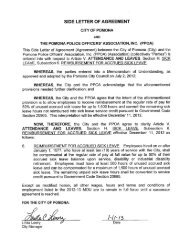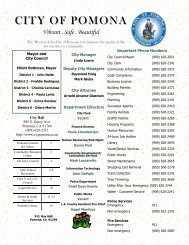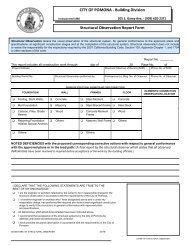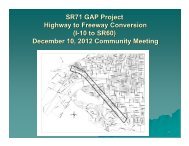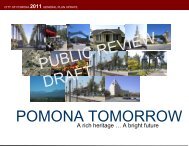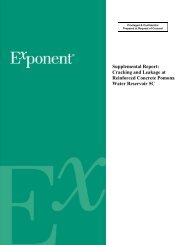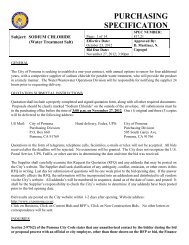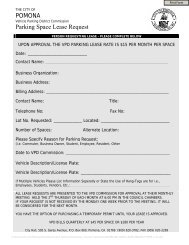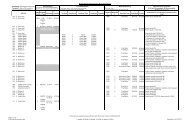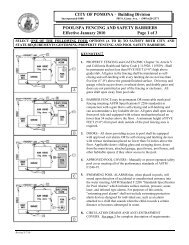Active Transportation Plan - City of Pomona
Active Transportation Plan - City of Pomona
Active Transportation Plan - City of Pomona
Create successful ePaper yourself
Turn your PDF publications into a flip-book with our unique Google optimized e-Paper software.
<strong>Pomona</strong> <strong>Active</strong> <strong>Transportation</strong> <strong>Plan</strong><br />
November 2012<br />
Chapter 2 – Existing Policy Framework<br />
• Ensure bicycle, pedestrian, and transit user needs are addressed and deficiencies identified during<br />
system and corridor planning, project initiation, scoping, and programming.<br />
• Ensure incorporation <strong>of</strong> bicycle, pedestrian, and transit travel elements in all Department<br />
transportation plans and studies.<br />
• Promote land uses that encourage bicycle, pedestrian, and transit travel.<br />
• Research, develop, and implement multimodal performance measures.<br />
California Complete Streets Act<br />
Assembly Bill 1358, the “California Complete Streets Act <strong>of</strong> 2008,” requires “that the legislative body <strong>of</strong> a<br />
city or county, upon any substantive revision <strong>of</strong> the circulation element <strong>of</strong> the general plan, modify the<br />
circulation element to plan for a balanced, multimodal transportation network that meets the needs <strong>of</strong> all<br />
users [including] motorists, pedestrians, bicyclists, children, persons with disabilities, seniors, movers <strong>of</strong><br />
commercial goods, and users <strong>of</strong> public transportation….” This provision <strong>of</strong> the law goes into effect on<br />
January 1, 2011. The law also directs the Governor’s Office <strong>of</strong> <strong>Plan</strong>ning and Research to amend its<br />
guidelines for the development <strong>of</strong> circulation elements so as to assist cities and counties in meeting the<br />
above requirement.<br />
Assembly Bill 32 and State Bill 375<br />
Senate Bill (SB) 375 is the implementation legislation for Assembly Bill (AB) 32. AB 32 requires the<br />
reduction <strong>of</strong> greenhouse gases (GHG) by 28 percent by the year 2020 and by 50 percent by the year 2050.<br />
GHGs are emissions – carbon dioxide chief among them – that accumulate in the atmosphere and trap<br />
solar energy in a way that can affect global climate patterns. The largest source <strong>of</strong> these emissions related<br />
to human activity is generated by combustion-powered machinery, internal combustion vehicle engines,<br />
and equipment used to generate power and heat. SB 375 tasks metropolitan and regional planning<br />
agencies with achieving GHG reductions through their Regional or Metropolitan <strong>Transportation</strong> <strong>Plan</strong>s.<br />
The reduction <strong>of</strong> the use the automobile for trip making is one method for reducing GHG emissions. This<br />
can be achieved through the use <strong>of</strong> modes other than the automobile, such as walking, bicycling, or using<br />
transit.<br />
Assembly Bill 1581 and Caltrans Policy Directive 09-06<br />
Assembly Bill (AB) 1581 provides direction that new actuated traffic signal construction and modifications<br />
to existing traffic signals include the ability to detect bicycles and motorcycles. It also calls for the timing<br />
<strong>of</strong> actuated traffic signals to account for bicycles. In response to AB 1581, Caltrans has issues Traffic<br />
Operations Policy Directive 09-06, which has proposed modifications to Table 4D-105(D) <strong>of</strong> the California<br />
Manual on Uniform Traffic Control Devices. The California Traffic Control Devices Committee is<br />
considering the proposed modifications.<br />
16




